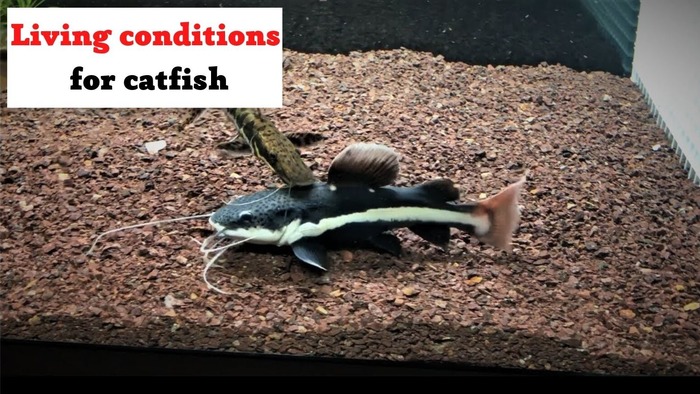
The proper name for the whiskers of a catfish is “Barbel,” and they are a fascinating part of the fish. But have you ever wondered if catfish whiskers grow back?
This article reveals the answer to that important question of whether catfish whiskers grow back. It also answers some other questions about catfish whiskers and how you can handle your catfish.
At the end of this post, you will know about some general features and traits of catfish, their identifying structure, the functions of their whiskers, and the right water conditions for rearing them.
Let’s get started!
About Catfish
Catfish are notorious for their noticeable whiskers. These whiskers, in strictly scientific terms, are called “Barbels”. Their striking resemblance to a cat’s whiskers is thought to be the main reason the fish is called catfish. The whiskers of a catfish usually come in pairs. Catfish typically have up to four pairs of whiskers. These include the nasal whiskers, the maxillary whiskers, and the chin whiskers.
There are thirty-seven catfish families. Catfish do not have scales. There are freshwater and saltwater varieties, and their bodies are usually naked with mucus-covered skin. Some species use their mucus-covered skin for cutaneous respiratory functions whereby the fish breathes through its skin. Some other species are covered in bony plates called scutes, which are body armor.
Catfish usually grow to shocking enormous length and weight under favorable conditions. They may grow up to 4.7 inches and even up to a few feet. They are very adaptable, making them easy to rear in warm climates.
Structure
Catfish have some characteristics that make them stand out. The first and most notorious are the barbels. They are located on the upper jaw of the catfish, with a pair on the catfish’s chin. Others are the sharp points of the spines of the pectoral and dorsal fin, the adipose fin, which is a unique fin of the catfish, salmon, and the trout, and the caudal fin.
There are five commonly caught species, and identifying them may be difficult. But here are a few distinctive features for telling one apart from the other.
The White Catfish
This species has whitish barbels or whiskers in their chin. It usually has a somewhat forked tail with a round lobe.
The Channel Catfish
This species has black barbels or whiskers and a forked tail with pointed lobes.
The Yellow Bullhead
This species has a long anal fin and a rounded tail. Its chin barbels or whiskers may be white or yellow.
The Brown Bullhead
This species has a less rounded tail that is almost square. It has gray-black or dark whiskers or barbel.
The Flathead Catfish
This species usually has a square tail with a long and flattened head. Its barbel or whiskers are typically yellowish-white, and its lower jaws usually extend beyond its upper jaw. In addition to all these distinctive features, it usually has mottled fins.
The Function of Whiskers for a Catfish

The barbels or whiskers of a catfish have specific functions that they perform. These unique barbels are made of skin instead of hair, as is the case with cats, and they consist of taste buds that help the fish taste. They also serve as olfactory sensors that allow the catfish to smell and navigate dark environments. So unlike the whiskers of a cat, they play different roles, especially in tasting with the barbels.
The function of the catfish whiskers is better appreciated with respect to their habitat. Catfish usually live in dark holes, the bottom of sands, and muddy places. In addition to this, they are night feeders as they typically search for food at night. This makes them rely heavily on their whiskers for navigation, feeling, and taste.
Many species of catfish also breathe through their skin. They absorb oxygen through their permeable skin in a process called cutaneous respiration. This helps them adapt and survive in mud puddles during periods with low rainfall while waiting for the rain to come.
Regrowing whiskers
Whiskers or barbels are an identifying feature of the catfish. But sometimes, these barbels or whiskers suffer injuries. Many injuries leave them damaged and cut shorter. Hence, the question, can they be regrown?
Catfishes can regrow their barbels if they get cut off or fall off. However, the probability of a regrowth depends on a few factors, including the water condition, the age of the fish, and the nutrition, to mention a few. The popular opinion is that the water condition is the most determining factor in the regrowth of the catfish whiskers.
The barbels are guaranteed to grow better with the proper water condition and nutrition. Hence, to ensure regrowth, you must pay attention to the needs of your catfish and provide it with a suitable environment for faster regrowth.
Note that the whiskers or barbels will grow back as long as they were not broken off too close to the nerve endings near the beginning of the barbel; it may take a few weeks.
Living conditions

Understanding the proper water parameters for your catfish pond will aid the adequate management of your pond, whether you keep them for commercial or other purposes. The adequate living conditions from hands-on experience are briefly discussed below.
Getting the temperature right
Catfish, like other marine life, are coldblooded animals. This implies that the water temperature dramatically influences their metabolism. Water temperature is crucial because it affects feed intake and growth rate.
For the African catfish, a temperature range between 26°C to 32°C (78 to 89 Fahrenheit) is acceptable. If the water temperature stays consistently between 16°C and 26°C (60 to 78 Fahrenheit), the consequences will include a reduction in feed intake, stress, and a tremendous drag in growth rate. In the event of prolonged stress, your fish may die.
Low water temperature may adversely affect the rate at which the waste in the water is converted. If the temperature falls below 15°C (59 Fahrenheit), your fish will stop growing, and you are likely to record mass loss to death.
High temperature is not suitable for your fish either because oxygen is not readily soluble in very warm water. For the African species, water temperature above 32°C (89 Fahrenheit) will stress the fish and eventually cause death.
It would be best if you checked the temperature for the species you’re rearing to know the right temperature to maintain.
Getting the pH right
PH level is another crucial factor for the correct water parameter of your fish pond.
A pH value of 6.5 to 7.5 is acceptable for fish in the pond. Your catfish may survive at a pH between 4 and 6, but you will experience a reduction in feed intake and a drag in the growth rate due to the stress they are going through.
If the pH value falls below 4, the high level of acidity will kill your catfish. Also, pH values of between 9-11 in the pond water will halt the growth rate of your catfish. If the pH rises above 11, your catfish will die from stress.
Alternatively, low pH aids higher proportions of ionized ammonia, which is less toxic to fish. But higher pH aids the lower proportion of ionized ammonia, and this is harmful to your catfish.
Low pH in the pond signifies a high level of carbon dioxide (CO2) in the water. This will create an unstable aquatic environment for your fish as the acidity of the water body increases. These water parameters play a considerable role in keeping catfish, especially when commercially farming them.
Monitoring the dissolved oxygen
It would be best to have a system of monitoring the level of dissolved oxygen in your pond. Dissolved oxygen is the quantity of oxygen present in a water body. All aquatic animals depend on dissolved oxygen to aid body metabolism.
Dissolved oxygen may be reduced when microorganisms decompose excess organic materials because the process consumes dissolved oxygen. Low levels of dissolved oxygen cause migration, a decline in fish health, and even death. Generally, dissolved oxygen levels below 3mg/liter are harmful to aquatic life.
Dissolved oxygen helps to break down harmful metabolic waste into less dangerous forms. An instance is the breakdown of ammonia into nitrates.
The requirements may vary for many species, but it would be best to maintain a dissolved oxygen level between 4mg/liter to saturation levels in the pond for the African catfish.
Extremely low dissolved oxygen levels will cause a reduction in growth rate. When the dissolved oxygen levels are lower than 1.5mg/liter, the length of time for achieving the set desired weight will be increased, and this will ultimately cause a loss of investment. Also, your catfish may die of stress.
Touching the whiskers
You can touch them, but you have to be careful. The whiskers are used to navigate their way because they do not entirely rely on their vision to move around. They count on the whiskers to feel, touch and taste. Touching them without care might cause damage to your fish.
Bottom line
Catfish are called so because they have whiskers similar to cat’s ones. The proper term for the whiskers is “barbel”. These barbels perform a variety of functions that are essential for the survival of the fish. They are fragile, and they are not poisonous. If you are looking to raise some catfish, this article is a good starting point to understanding them.
- Snail Mantle Collapse – Here’s What Every Pet Owner Should Know - April 2, 2023
- Algaefix Killed My Fish – What Have I Done Wrong? - March 2, 2023
- How Long Can Live Rock Be Out of Water? And What Will Happen Then? - February 2, 2023




